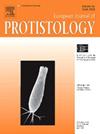Molecular phylogeny and taxonomy of three anaerobic ciliates including Bothrostoma aporobustum nov. spec. (Ciliophora, Metopida)
IF 1.6
2区 生物学
Q4 MICROBIOLOGY
引用次数: 0
Abstract
The order Metopida is a species-rich taxon within the obligate anaerobic ciliate class Armophorea. Metopids have garnered increasing interest due to their potential to shed light on mitochondrial evolution and symbiotic relationship between eukaryotes and prokaryotes. However, the majority of metopid species remain poorly or incompletely studied, largely due to limitations in earlier research methodologies. In this study, three species, Bothrostoma aporobustum nov. spec., Brachonella mitriformis and Planometopus contractus, were examined using a morpho-molecular approach. The new species is distinguished by a short proboscis-shaped snout, an average of 33 somatic kineties, and 21 adoral membranelles. Brachonella mitriformis is characterized by a broad obpyriform body with a narrow and flattened posterior end, an average of 53 somatic kineties and 77 adoral membranelles, and unevenly distributed dikinetids on the preoral dome. Phylogenetic analyses confirmed the validity and monophyly of the genera Bothrostoma and Brachonella, and robustly resolved the phylogenetic position of Brachonella mitriformis. Representatives of geographically distant populations of Planometopus contractus are morphologically highly similar and cluster together with strong support in SSU rRNA gene phylogenies.
包括Bothrostoma aporobustum 11 . spec在内的3种厌氧纤毛虫的分子系统发育与分类
mettopida目是专性厌氧纤毛虫纲Armophorea中的一个物种丰富的分类单元。由于具有揭示线粒体进化和真核生物与原核生物共生关系的潜力,类胞体已经获得了越来越多的兴趣。然而,由于早期研究方法的限制,大多数类甲物种的研究仍然很差或不完全。本研究采用形态-分子方法对3种Bothrostoma aporobustum 11 . spec、三叉状短臂杆菌(Brachonella mitriformis)和Planometopus contractus进行了研究。新种的特征是短鼻状口鼻,平均33个体动力,21个口膜。三叉状臂杆菌体宽,呈双梨形,后端窄而扁平,平均有53个体动体和77个口膜,口前穹丘上双动体分布不均匀。系统发育分析证实了Bothrostoma属和Brachonella属的有效性和单系性,有力地确定了三分形Brachonella的系统发育地位。在地理上相距遥远的平跖龙种群的代表在形态上高度相似,并且在SSU rRNA基因系统发育上有很强的支持。
本文章由计算机程序翻译,如有差异,请以英文原文为准。
求助全文
约1分钟内获得全文
求助全文
来源期刊

European journal of protistology
生物-微生物学
CiteScore
4.60
自引率
20.70%
发文量
55
审稿时长
14.6 weeks
期刊介绍:
Articles deal with protists, unicellular organisms encountered free-living in various habitats or as parasites or used in basic research or applications. The European Journal of Protistology covers topics such as the structure and systematics of protists, their development, ecology, molecular biology and physiology. Beside publishing original articles the journal offers a forum for announcing scientific meetings. Reviews of recently published books are included as well. With its diversity of topics, the European Journal of Protistology is an essential source of information for every active protistologist and for biologists of various fields.
 求助内容:
求助内容: 应助结果提醒方式:
应助结果提醒方式:


